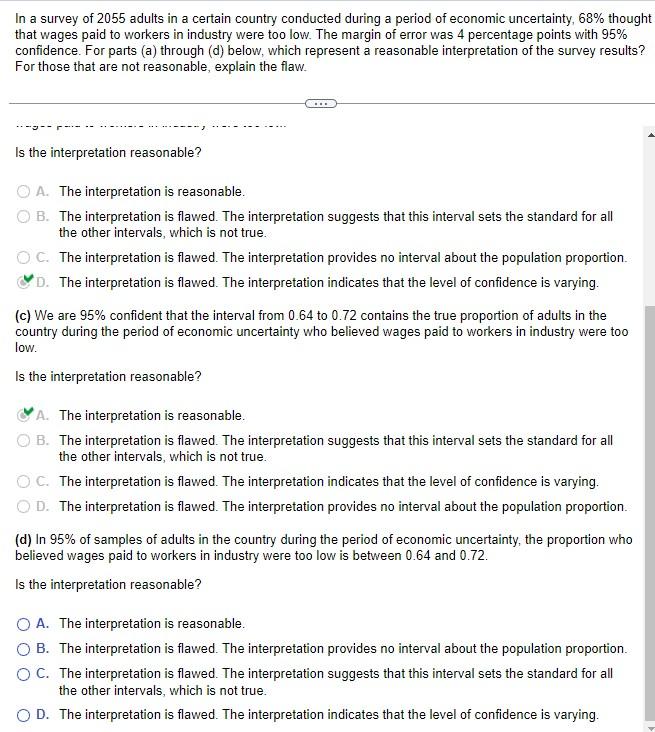Home /
Expert Answers /
Statistics and Probability /
in-a-survey-of-2055-adults-in-a-certain-country-conducted-during-a-period-of-economic-nbsp-uncert-pa710
(Solved): In a survey of 2055 adults in a certain country conducted during a period of economic uncert ...
In a survey of 2055 adults in a certain country conducted during a period of economic? uncertainty, 68?%
thought that wages paid to workers in industry were too low. The margin of error was 4 percentage points with
95?% confidence. For parts? (a) through? (d) below, which represent a reasonable interpretation of the survey? results? For those that are not? reasonable, explain the flaw.
d) In 95?% of samples of adults in the country during the period of economic? uncertainty, the proportion who believed wages paid to workers in industry were too low is between 0.64 and 0.72.
In a survey of 2055 adults in a certain country conducted during a period of economic uncertainty, \( 68 \% \) thought that wages paid to workers in industry were too low. The margin of error was 4 percentage points with \( 95 \% \) confidence. For parts (a) through (d) below, which represent a reasonable interpretation of the survey results? For those that are not reasonable, explain the flaw. Is the interpretation reasonable? A. The interpretation is reasonable. B. The interpretation is flawed. The interpretation suggests that this interval sets the standard for all the other intervals, which is not true. C. The interpretation is flawed. The interpretation provides no interval about the population proportion. D. The interpretation is flawed. The interpretation indicates that the level of confidence is varying. (c) We are \( 95 \% \) confident that the interval from \( 0.64 \) to \( 0.72 \) contains the true proportion of adults in the country during the period of economic uncertainty who believed wages paid to workers in industry were too low. Is the interpretation reasonable? A. The interpretation is reasonable. B. The interpretation is flawed. The interpretation suggests that this interval sets the standard for all the other intervals, which is not true. C. The interpretation is flawed. The interpretation indicates that the level of confidence is varying. D. The interpretation is flawed. The interpretation provides no interval about the population proportion. (d) In \( 95 \% \) of samples of adults in the country during the period of economic uncertainty, the proportion who believed wages paid to workers in industry were too low is between \( 0.64 \) and \( 0.72 \). Is the interpretation reasonable? A. The interpretation is reasonable. B. The interpretation is flawed. The interpretation provides no interval about the population proportion. C. The interpretation is flawed. The interpretation suggests that this interval sets the standard for all the other intervals, which is not true.
Expert Answer
From the given data : point estimate p = 0.68 margin of error E = 0.04 confidence interval = point estimate marg
